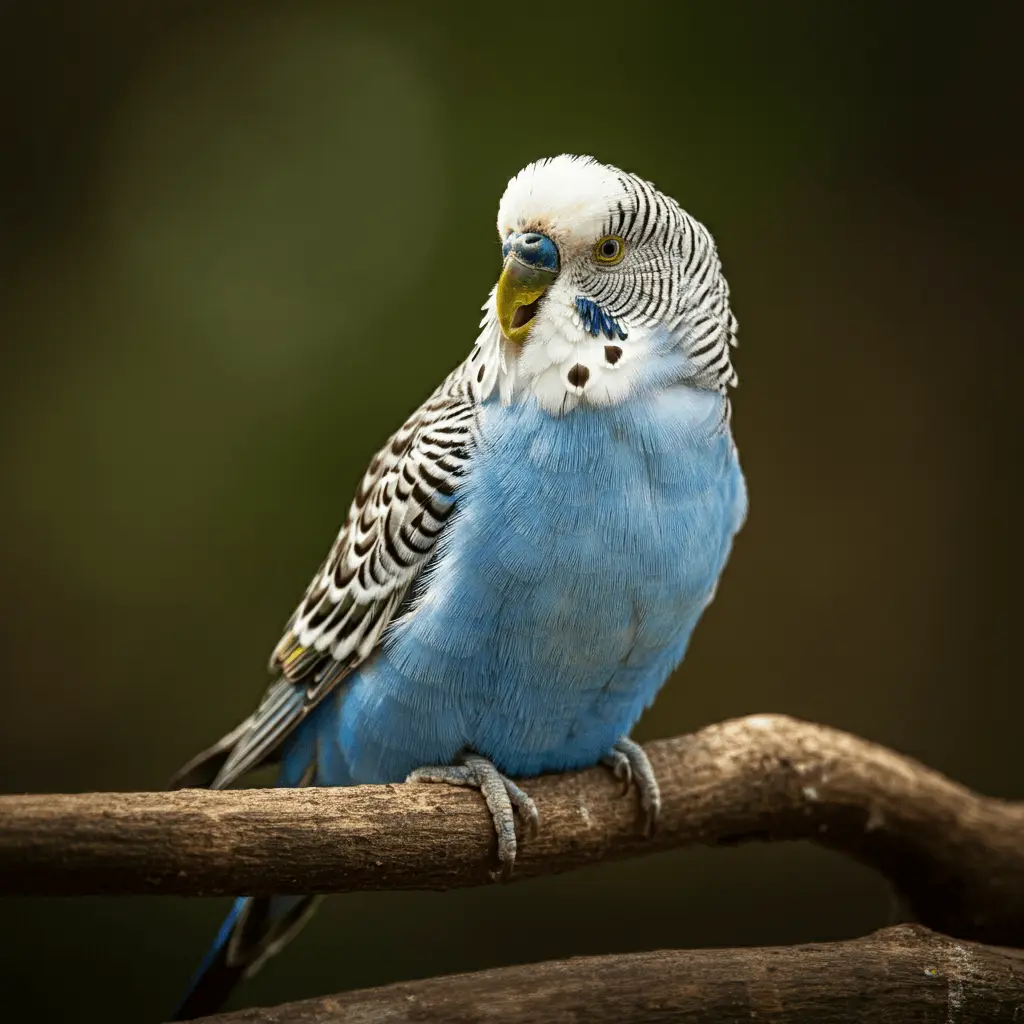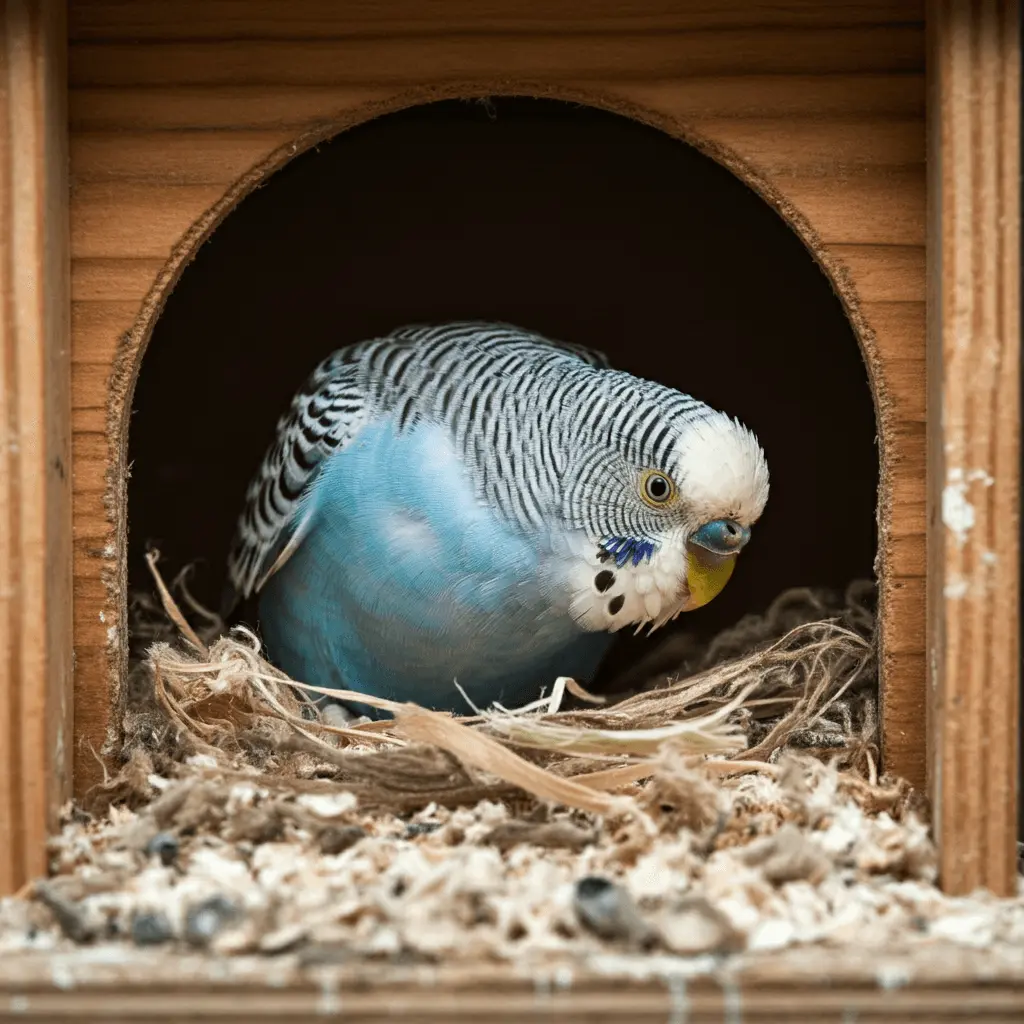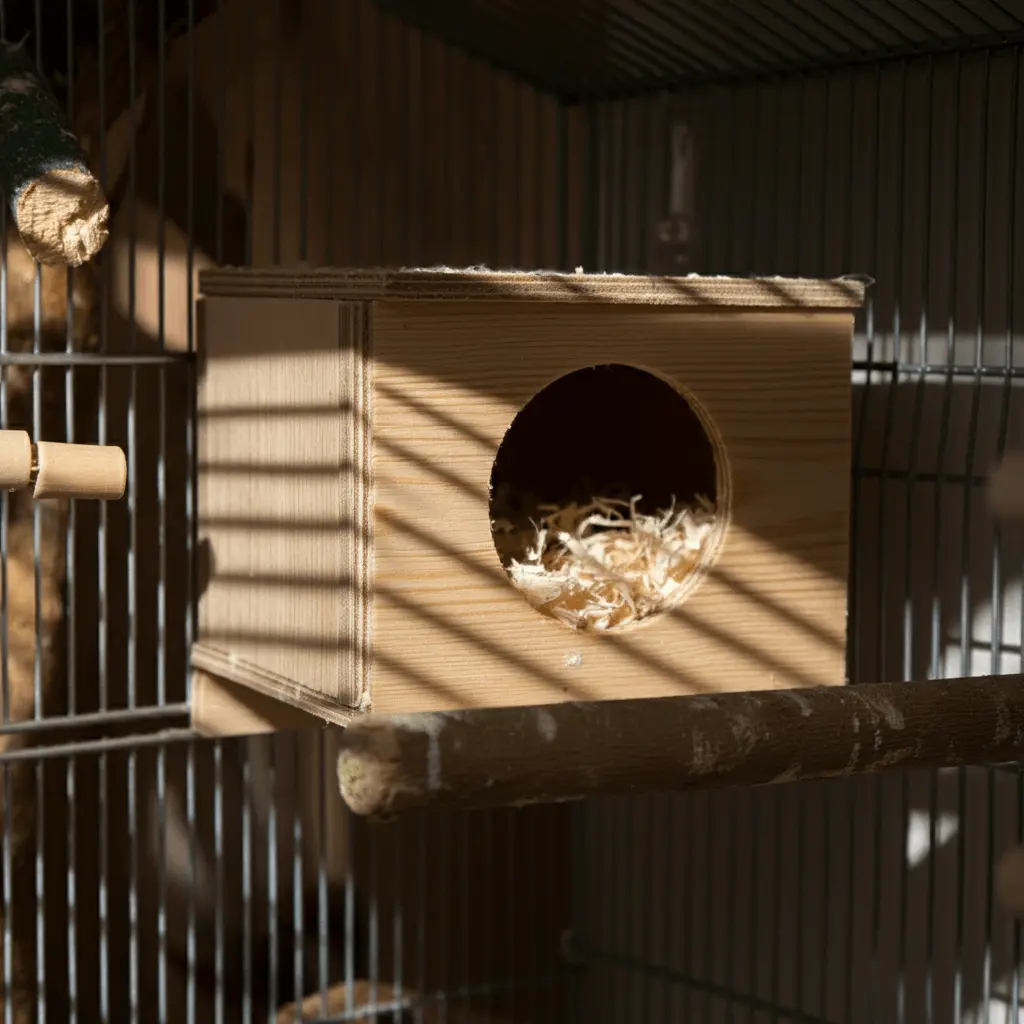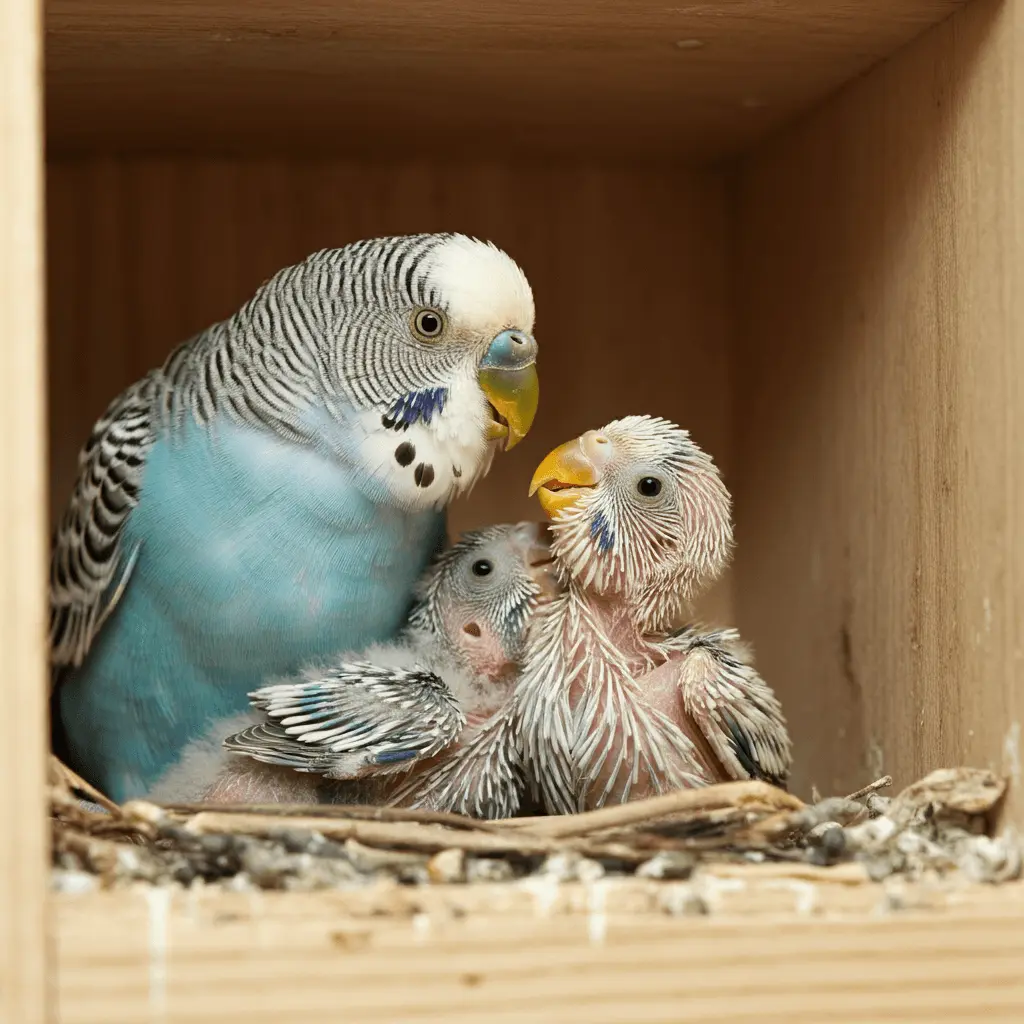Understanding the Budgerigar Mating Season
The budgerigar mating season is an exciting time for bird owners, as it marks the period when these colorful birds are ready to breed. Typically, the best time to breed budgies is during the spring and early summer when the days are longer and the temperatures are just right. Understanding the signs and behaviors associated with the budgerigar mating season can help you prepare your birds for a successful breeding experience.
During the mating season, you’ll notice specific changes in your budgie’s behavior. Male budgies often become more vocal, showing off their bright plumage to attract a mate. They might also start feeding the female as part of their courtship rituals. On the other hand, female budgies might spend more time in the nesting box, preparing it for egg-laying.

A male budgerigar sings loudly, a common behavior during the mating season to attract a mate.
It’s essential to provide the right environment during this period. A well-prepared budgie nesting box is crucial for encouraging successful mating and ensuring that the female has a safe place to lay her eggs. Proper lighting, a balanced diet, and a quiet environment can also play a significant role in creating the ideal conditions for your budgies during this season.
Understanding these key aspects of the budgerigar mating season will not only make the process smoother but will also increase the chances of successful breeding. By paying attention to their behavior and preparing accordingly, you’ll be well on your way to helping your budgies thrive during this special time.
Signs Your Budgerigar is Ready to Mate
Recognizing the signs that your budgerigar is ready to mate is key to ensuring a successful breeding season. Budgies, like many birds, display specific behaviors when they are in the mood to breed, and understanding these can help you prepare them for mating.
One of the most noticeable signs that your budgerigar is ready to mate is increased vocalization, especially in males. Male budgies will often sing and chatter more than usual, trying to attract the attention of a female. This heightened vocal activity is their way of showing off and letting potential mates know they are ready.
In addition to vocalization, you might observe males engaging in more frequent displays of their plumage. They’ll fluff up their feathers, bob their heads, and may even perform little dances to impress a female. These courtship behaviors are all part of the natural process of preparing for mating.
Female budgerigars, on the other hand, will exhibit nesting behaviors as they get ready to mate. You’ll see them spending more time in and around the nesting box, rearranging the materials inside, and even sitting in the box as if they are practicing for egg-laying. This nesting activity is a strong indicator that she is ready to mate and start a family.

A budgerigar begins preparing its nest inside a wooden box, a clear sign that it is ready to mate and lay eggs.
Another sign to watch for in both male and female budgies is mutual preening. This is when the birds groom each other, which strengthens their bond and prepares them for mating. If you notice your budgies engaging in this affectionate behavior, it’s a good sign that they are ready to mate.
By paying close attention to these signs—like increased vocalization, feather displays, and nesting behavior—you can better understand when your budgerigars are ready to mate. Preparing them with the right environment and care during this time will set the stage for a successful mating season.
Preparing the Nesting Box for Mating Season
A well-prepared nesting box is essential for a successful budgerigar mating season. The nesting box serves as the safe haven where the female budgie will lay her eggs and care for her chicks. To ensure everything goes smoothly, it’s important to get the nesting box ready before the mating season begins.
First, choose the right nesting box. A wooden box with a secure lid is ideal, as it provides a natural and comfortable environment for your budgie. The box should be spacious enough for the female to move around but not so large that it feels too open or insecure. Typically, a box measuring around 12x12x12 inches works well for most budgerigars.
Inside the nesting box, you’ll need to provide suitable bedding material. Soft, clean wood shavings are a great choice, as they offer warmth and comfort while also absorbing moisture. Avoid using materials that could cause harm or discomfort, like rough or sharp objects. The bedding should be about an inch thick, giving the female a soft surface to lay her eggs.
Positioning the nesting box correctly is also crucial. It should be placed in a quiet, undisturbed part of the cage, away from direct sunlight and drafts. This will help create a calm environment that encourages your budgies to mate and feel secure. Make sure the box is easily accessible for the female budgie but also high enough to make her feel safe from any potential disturbances.

A well-prepared wooden nesting box is key to ensuring budgerigars have a comfortable place to lay their eggs.
Regularly check the nesting box during the mating season to ensure it remains clean and comfortable. Remove any soiled bedding and replace it with fresh material as needed. This will help prevent the spread of bacteria and keep the environment healthy for both the mother and her chicks.
Preparing the nesting box properly not only supports the female budgie during egg-laying but also sets the stage for a successful breeding experience. By providing a safe, clean, and comfortable nesting space, you’ll help ensure that the budgerigar mating season goes smoothly and results in healthy, happy chicks.
Dietary Requirements During the Mating Season
Proper nutrition is critical during the budgerigar mating season, as it directly impacts the health of both the parents and their future chicks. During this period, your budgies will need a diet that provides them with the extra energy and nutrients required for successful breeding and egg production.
The Foundation: Seeds and Pellets
Start by ensuring that your budgerigars have access to high-quality seeds and pellets. These should form the base of their diet, providing essential proteins and fats. However, during the mating season, it’s important to supplement their diet with additional foods rich in vitamins and minerals to meet their increased nutritional needs.
Boosting Nutrition with Fresh Vegetables
Fresh vegetables are a must during the mating season. Leafy greens, carrots, and broccoli are excellent choices, as they offer a variety of nutrients that support overall health and reproductive success. These vegetables should be washed thoroughly and chopped into small, manageable pieces for your budgies to enjoy.
Essential Calcium for Strong Eggshells
Calcium is particularly important during the mating season, especially for female budgerigars. Calcium helps with the formation of strong eggshells and supports the development of healthy chicks. You can provide calcium by offering cuttlebone or mineral blocks, or by sprinkling calcium powder over their food. Crushed eggshells, offered in small amounts, are another good source of calcium.
Incorporating Protein for Growth and Recovery
Protein is another crucial component of a budgie’s diet during the mating season. Protein supports the growth and development of the chicks and helps the female recover after laying eggs. Foods like boiled eggs, cooked legumes, and sprouted seeds are great sources of protein that can be easily incorporated into your budgies’ meals.
Hydration and Additional Supplements
Don’t forget about hydration. Fresh, clean water should always be available, as proper hydration is essential for both egg production and the overall well-being of your budgerigars. You might also consider adding a liquid multivitamin to their water during this time to ensure they’re getting all the necessary nutrients.
By carefully managing the dietary requirements of your budgerigars during the mating season, you’ll help ensure that they are in the best possible condition to breed and raise healthy chicks. A balanced diet rich in seeds, fresh vegetables, calcium, and protein will provide the nutritional foundation your budgies need for a successful and stress-free mating season.
Behavioral Changes to Expect During Mating Season
During the budgerigar mating season, you’ll notice a variety of behavioral changes in your birds as they prepare to breed. Understanding these behaviors can help you provide the right environment and care, ensuring a smooth and successful mating process.
Increased Vocalization and Singing
One of the first signs of the mating season is an increase in vocalization, particularly from the male budgerigars. Males will sing more frequently and with greater intensity, using their voices to attract a mate. This singing is often accompanied by head-bobbing and feather displays, as the males try to impress the females with their vitality and readiness to breed.
Courtship Rituals and Displays
Courtship behaviors are common during the mating season. Male budgerigars will often perform elaborate displays to win over a female. These displays can include fluffing up their feathers, spreading their wings, and even dancing. It’s not unusual to see males feeding females as a sign of affection and bonding. This feeding behavior is part of the courtship ritual and helps strengthen the pair’s bond before mating.
Nesting Behavior in Females
Female budgerigars will exhibit nesting behaviors as they prepare for egg-laying. You might notice the female spending more time in the nesting box, rearranging the bedding, and creating a comfortable space for her eggs. She may also become more territorial, protecting the nesting area from other birds. This nesting instinct is a clear indicator that the mating season is in full swing and that she’s preparing to lay eggs.
Mutual Preening and Bonding
Mutual preening is another behavior that becomes more pronounced during the mating season. Both male and female budgerigars will engage in this activity, grooming each other as a way to strengthen their bond. This behavior not only reinforces their pair bond but also helps keep their feathers in top condition for the breeding process.
Increased Aggression or Territorial Behavior
While most behaviors during the mating season are focused on bonding and courtship, you might also notice a slight increase in aggression or territorial behavior, especially from the female. She may become more protective of her nesting area and less tolerant of other birds or disturbances. This is a natural response to her instinct to create a safe environment for her future chicks.
By understanding these behavioral changes during the budgerigar mating season, you can better anticipate your birds’ needs and provide them with the care and environment they require. Whether it’s giving them more space, ensuring their nesting box is ready, or simply allowing them to engage in their courtship rituals, your support will help ensure a successful and stress-free mating season.
Common Challenges and How to Address Them
The budgerigar mating season is an exciting time, but it’s not without its challenges. As a bird owner, being aware of these potential issues and knowing how to address them can make a big difference in ensuring a successful breeding experience.
Aggression Between Budgies
One of the most common challenges during the mating season is aggression between budgies, particularly when it comes to territory or competition for a mate. Males may become more territorial, leading to squabbles, while females may defend their nesting area more fiercely. To address this, ensure that your budgies have enough space and provide multiple nesting boxes if you have more than one pair. Separating particularly aggressive birds might also be necessary to prevent injuries.
Egg Binding in Females
Egg binding, where a female budgerigar has difficulty laying an egg, is a serious concern during the mating season. This condition can be life-threatening if not addressed promptly. To reduce the risk, ensure your female budgie has a calcium-rich diet, as calcium is crucial for egg formation. Providing a warm, stress-free environment can also help. If you suspect egg binding, it’s important to seek veterinary care immediately.
Infertility or Lack of Interest in Mating
Sometimes, despite all your preparations, your budgies may show little interest in mating, or you may find that the eggs are infertile. Infertility can be due to several factors, including age, health, or stress. To encourage mating, make sure your budgies are in peak health, with a balanced diet and minimal stress. Providing privacy and reducing disturbances can also help them feel more secure and increase the likelihood of successful mating.
Abandoned Eggs or Chicks
It’s not uncommon for a female budgerigar to abandon her eggs or chicks, especially if she’s a first-time mother. This can happen if she feels threatened or if the environment isn’t ideal. To prevent this, ensure that the nesting box is placed in a quiet, secure location where she feels safe. If abandonment does occur, you may need to step in and hand-rear the chicks, which requires careful attention and the right equipment.
Overbreeding and Exhaustion
Overbreeding can be a serious issue, particularly if your budgies are allowed to mate repeatedly without adequate rest between clutches. This can lead to exhaustion and health problems for the female. To prevent overbreeding, it’s important to monitor their mating and give them breaks between breeding cycles. If necessary, separate the pair for a period to ensure the female has time to recover and regain her strength.
By being aware of these common challenges during the budgerigar mating season and taking proactive steps to address them, you can help ensure a healthy, successful breeding experience for your birds. Providing the right care, environment, and attention will make all the difference in supporting your budgies through this important time.
What to Do After the Mating Season
After the budgerigar mating season has ended, your focus should shift to ensuring the well-being of both the parents and the new chicks. The period following mating is just as important as the mating season itself, and proper care will help your birds recover and thrive.
Monitor the Health of the Female
The first thing to do after the mating season is to closely monitor the health of the female budgerigar. Laying eggs and caring for chicks can be physically demanding, so it’s important to ensure she’s getting enough rest and nutrition. Continue providing a calcium-rich diet, as this will help her recover and prevent conditions like egg binding in the future. Observe her behavior for any signs of exhaustion or illness, and if you notice anything unusual, consult with an avian vet.
Care for the Chicks
If your budgies have successfully bred and hatched chicks, the next step is ensuring the young birds are properly cared for. Make sure the nesting box remains clean and that the chicks are kept warm and well-fed. The mother will do most of the feeding at first, but you should be prepared to assist if necessary, especially if the chicks appear weak or if the mother is not providing enough food.

A parent budgerigar carefully feeding its chicks in a wooden nesting box during the peak of the breeding season.
Gradually Transition Back to Normalcy
Once the chicks are old enough to leave the nest, you can begin to transition your birds back to their regular routines. Gradually reduce the extra supplements and return to their standard diet of seeds and pellets, while still offering fresh vegetables and occasional protein sources. This will help them adjust back to their normal lifestyle while maintaining their health.
Give Your Budgies a Breeding Break
It’s important to give your budgies a break from breeding after the mating season. Overbreeding can lead to health problems, particularly for the female, so it’s essential to allow a period of rest. During this time, separate the male and female if necessary, and provide plenty of opportunities for play and exercise to keep them engaged and healthy without the pressures of breeding.
Plan for Future Breeding Seasons
As you wrap up the current mating season, take some time to reflect on what worked well and what could be improved for future breeding seasons. Maybe you need to adjust the diet, rearrange the cage setup, or invest in new nesting boxes. Learning from each season will help you become more adept at managing your budgerigars’ breeding cycles and ensuring their health and happiness.
By following these steps after the budgerigar mating season, you’ll help your birds recover, care for their chicks, and prepare for future breeding seasons. Proper post-mating care is crucial to maintaining the long-term health of your budgies and ensuring successful breeding in the years to come.
Frequently Asked Questions (FAQs) About Budgerigar Mating Season
The budgerigar mating season often raises many questions for bird owners, especially those who are new to breeding these colorful parrots. Below are some of the most frequently asked questions about budgerigar mating season, along with clear, concise answers to help you navigate this important time.
1. When does the budgerigar mating season typically occur?
The budgerigar mating season usually takes place during the spring and early summer, when the days are longer, and temperatures are warmer. This period mimics their natural breeding conditions in the wild, making it the ideal time for them to mate and raise chicks.
2. How can I tell if my budgerigars are ready to mate?
Signs that your budgerigars are ready to mate include increased vocalization, particularly from males, and more frequent courtship behaviors like head-bobbing and feather displays. Females may start showing nesting behaviors, such as spending more time in the nesting box and rearranging the bedding.
3. What should I feed my budgerigars during the mating season?
During the mating season, it’s important to provide a balanced diet that includes high-quality seeds, fresh vegetables, and extra protein sources like boiled eggs and sprouted seeds. Don’t forget to provide calcium-rich foods or supplements, as calcium is crucial for egg production.
4. How do I prepare a nesting box for my budgies?
A good nesting box should be made of wood and have a secure lid. It should be placed in a quiet, undisturbed part of the cage. Inside, provide soft, clean wood shavings as bedding, and ensure the box is spacious enough for the female to move comfortably.
5. What are common challenges during the mating season, and how can I address them?
Common challenges include aggression between budgies, egg binding in females, and the risk of overbreeding. To address these issues, provide enough space and multiple nesting boxes, ensure a calcium-rich diet, and give your budgies a break from breeding after the season ends.
6. What should I do if my female budgie abandons her eggs or chicks?
If a female budgie abandons her eggs or chicks, you may need to intervene by hand-rearing the chicks. This requires careful attention, proper feeding, and maintaining the right temperature to ensure the chicks’ survival.
7. How often can budgerigars breed?
Budgerigars can breed several times a year, but it’s important to avoid overbreeding. Giving them a break between breeding cycles is essential to prevent exhaustion and health issues, particularly for the female.
8. What should I do after the mating season ends?
After the mating season, monitor the health of the female, ensure the chicks are cared for, and gradually transition your birds back to their regular routines. Give your budgies a breeding break and reflect on any adjustments needed for future seasons.
9. Can I breed budgerigars in captivity?
Yes, budgerigars can be bred successfully in captivity, provided they are given the right environment, diet, and care. Breeding budgies in captivity requires careful attention to their needs during the mating season and a commitment to ensuring their well-being.
These FAQs cover the most common concerns and questions about the budgerigar mating season. By understanding these aspects, you’ll be better equipped to manage your budgies during this important time and ensure a successful and healthy breeding experience.
Conclusion
Navigating the budgerigar mating season can be a rewarding experience, both for you and your feathered friends. By understanding the signs that your budgerigars are ready to mate, preparing the nesting box, providing the right diet, and addressing common challenges, you’ll set the stage for a successful breeding season. It’s important to monitor your birds closely, ensure they have everything they need, and give them the care and attention they deserve.
Whether you’re a seasoned breeder or new to the process, the key to a smooth budgerigar mating season lies in preparation and knowledge. From the early signs of mating readiness to caring for the chicks after they hatch, each step plays a crucial role in the overall success of the season. By following the guidance provided in this post, you’ll not only help your budgies thrive during the mating season but also ensure their long-term health and happiness.
Remember, every budgerigar is unique, and their needs may vary. Stay attentive, be patient, and enjoy the journey of watching your budgies grow and flourish during this special time. With the right care and environment, you’ll soon be welcoming a new generation of healthy, happy budgerigars.

